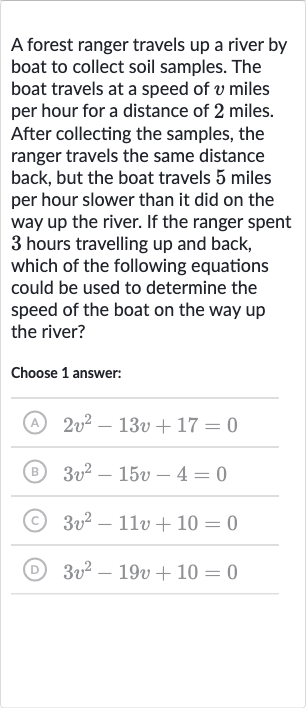AI tutor
Welcome to Bytelearn!
Let’s check out your problem:

A forest ranger travels up a river by boat to collect soil samples. The boat travels at a speed of miles per hour for a distance of miles. After collecting the samples, the ranger travels the same distance back, but the boat travels miles per hour slower than it did on the way up the river. If the ranger spent hours travelling up and back, which of the following equations could be used to determine the speed of the boat on the way up the river?Choose answer:(A) (B) (C) (D)
Full solution
Q. A forest ranger travels up a river by boat to collect soil samples. The boat travels at a speed of miles per hour for a distance of miles. After collecting the samples, the ranger travels the same distance back, but the boat travels miles per hour slower than it did on the way up the river. If the ranger spent hours travelling up and back, which of the following equations could be used to determine the speed of the boat on the way up the river?Choose answer:(A) (B) (C) (D)
- Denote Speed and Distance: Let's denote the speed of the boat on the way up the river as miles per hour. The distance traveled up the river and back is the same, which is miles each way. The speed on the way back is miles per hour because it's miles per hour slower. We need to find the total time spent for both trips to be hours. The time taken to travel a certain distance is equal to the distance divided by the speed. So, the time taken to go up the river is hours, and the time taken to come back is hours. The sum of these times should equal hours.
- Set Up Equation: We can set up the equation as follows:Time up the river + Time back = Total timeTo solve for , we need to find a common denominator and combine the terms on the left side of the equation.
- Find Common Denominator: The least common denominator (LCD) for and is . We multiply each term by the LCD to clear the fractions:This simplifies to:
- Simplify Equation: Now we distribute and combine like terms:To set the equation to zero, we bring all terms to one side:
- Combine Like Terms: Combine the terms:This is a quadratic equation in standard form, which can be used to solve for , the speed of the boat on the way up the river.
